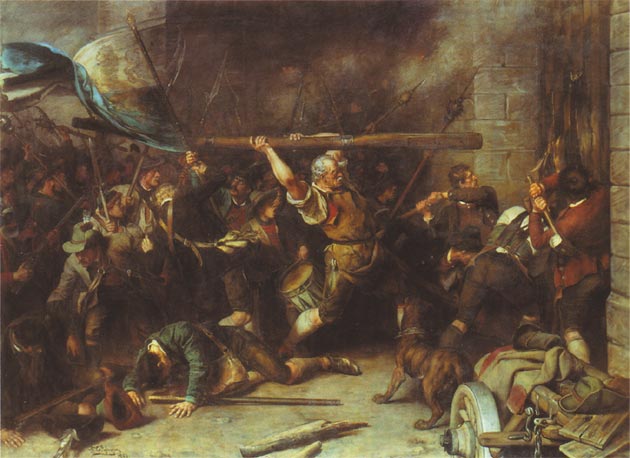
On Christmas Eve in 1705, a group of peasants, farmers and working men from all across Upper Bavaria, gathered in Sendling, a few kilometers southwest of Munich. They did not come to hear priests or other holy men speak about Jesus or Christmas or anything else religious. They came to overthrow the yoke of the Austrian Habsburgs. These Bavarians were armed with little more than sharp and blunt objects one might find laying around most barns or bellows, a fierce streak of independence, and a stubbornness to acquire that freedom from the Austrian Habsburgs which supplanted sensibility. And yet they gathered.

The politics behind the uprising were extremely complex, as these things tend to be. The short of it was that the ruler of Bavaria, Maximilian II, better known in these parts as Max Emanuel, did what Bavaria’s rulers had usually avoided. Max Emanuel chose the losing side (France) in a Europe-wide conflict, the War of Spanish Succession (WSS). The Bavarians fought with the French against the Austrian Habsburgs who were allied with the British (led by the Duke of Marlborough). This, after being on the correct side and instrumental in heading of the major threat posed by the Ottomans at the gates of Vienna in 1689, saving the Habsburg emperor’s fat from the fire.

But in Europe in those days, alliances changed daily, and the Bavarians were eliminated from the WSS in 1704. The Franco-Bavarian army was crushed at the Battle of Blenheim (100 km northwest of Munich), the Bavarians knocked out of the war. (It is considered by many British historians to be the Redcoats greatest continental victory. Winston Churchill wrote about the moving British columns, “A scarlet caterpillar, upon which all eyes were at once fixed, began to crawl steadfastly day by day across the map of Europe, dragging the whole war with it.)

Things were not too bad in Bavaria as a result of the defeat until the newly crowned Habsburg emperor, Joseph I, decided to do what his recently deceased father, Leopold I, had not. He occupied the territory of Upper Bavaria, Lower Bavaria and the Upper Palatinate, and chose to take over the army garrisons and even force Bavarian peasants and farmers to harbor Habsburg troops. Rubbing salt in wounds, Joseph I, who it seems suffered from ‘small hands disease’ (always trying to live up to, or beyond, the legend of his father), began taxing the Bavarians at an exorbitant level. The troops, doing what troops are wont to do, were very brutal on the local population during the collection of the new taxes, and one can surmise that they also forced themselves on the population in other, non-Christian ways. So then began the slogan in the Bavarian hinterlands, “Lieber bairisch sterben als kaiserlich verderben” (Better to die a Bavarian than as a Kaiser’s spoils).

Max Emanuel had continued his fight in the Netherlands, and so there was a bit of a power vacuum in Bavaria amongst the Bavarians as Joseph’s rule became tighter. Many former leaders in the army began to mobilize peasants and other citizens into mobs. Other groups were led by mere citizens or farmers or smiths. In what may well have been the first true democratic action in Europe, a mob in Braunau am Inn (then it was part of Bavaria, today part of Austria) met, in what is known today as the ‘Braunauer Parliament’.

The mobs gathered and began to take over a few small garrisons across Bavaria in December 1705, but when they attempted to take over Munich that was too much for the Habsburgs. On Christmas Eve, after the planned opening of the gates by insiders aligned with the rebels failed to materialize, the under-armed peasants attempted to storm the walls of Munich at Isartor. They were unsuccessful. They retreated and were then pushed back even further by the occupying Imperial soldiers. Then, around one in the morning, the peasant and citizen ‘army’ fell back to Sendling and took up entrenched positions. The soldiers garrisoning Munich followed, and after a brief skirmish, the insurgents surrendered.

The Habsburgs and their mercenary soldiers took no mercy upon the hapless Bavarians. The soldiers who followed the rebel insurgents out of Munich to Sendling were mostly Franconian Imperial troops from Würzburg (Würzburg is in Franconia, and is not Bavarian, though they share the same geography today!) and a large contingent of Hungarian hussars. Many Bavarians were slaughtered on the spot after surrendering their weapons and seemingly pardoned by Imperial officers. (The officers perhaps recognized the dangerous precedent set by the democratic/parliamentary meeting in Braunau.) The Bavarians sought refuge in the cemetery of the Old Parish Church of Saint Margaret in Sendling, hoping that the Christian soldiers would at least give them a stay of execution on Christmas. None was given. One of the last citizen insurgents to meet his death in the cemetery is known as the ‘Schmied of Kochel’ (the [black]smith of Kochel).

The final numbers are numbing. Over 1,100 Bavarians died on that bloody Christmas, at the cost of 40 imperial soldiers.
Today, the ‘Bavarian Uprising’ (this uprising is considered the first real modern revolution by some historians) is still celebrated and remembered in Sendling. Also, a depiction of the ‘battle’ can be seen on a piece painted by Wilhelm Lindenschmit der Elder on the Old Parish Church of Saint Margaret in Sendling. Every year, one can see the “Gebirgsschützen (Mountain Corps or Protectors)” memorialize this event on 24 December in Sendling. In Munich, the ‘Plinganser Straβe’ is named in honor of another one of the citizen leaders of the revolt.



Amazing read!
LikeLike
Thank you very much!
LikeLike